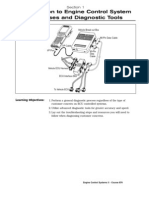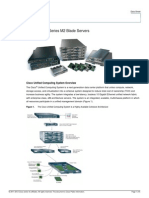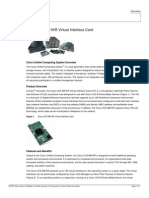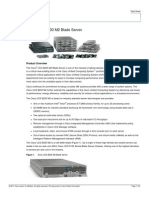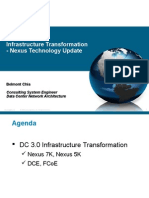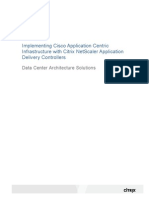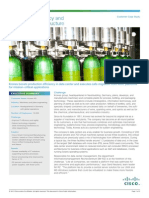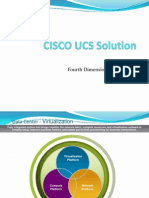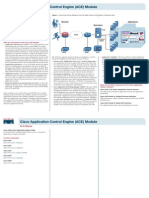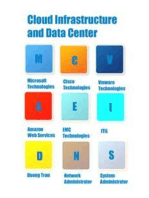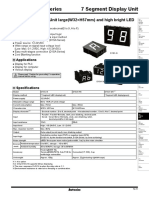At A Glance c45-531021
At A Glance c45-531021
Uploaded by
ChiTownITCopyright:
Available Formats
At A Glance c45-531021
At A Glance c45-531021
Uploaded by
ChiTownITOriginal Title
Copyright
Available Formats
Share this document
Did you find this document useful?
Is this content inappropriate?
Copyright:
Available Formats
At A Glance c45-531021
At A Glance c45-531021
Uploaded by
ChiTownITCopyright:
Available Formats
Cisco UCS B200 M1 Blade Server
Simplicity, Efficiency, Performance, and Density Unified Computing Through Virtualization
The Cisco Unified Computing System is a next-generation data center platform that unites compute, network, storage access, and virtualization into a cohesive system designed to reduce total cost of ownership (TCO) and increase business agility. The system integrates a lowlatency, lossless 10 Gigabit Ethernet unified network fabric with enterprise-class, x86-architecture servers. The system is an integrated, scalable, multichassis platform in which all resources participate in a unified management domain. more industry-standard memory compared to previousgeneration Intel Xeon two-socket servers. A Cisco UCS 5108 Blade Server Chassis can house up to eight Cisco UCS B200 M1 Blade Servers, with a maximum of 320 per Cisco Unified Computing System.
Figure 1: Cisco UCS B200 M1 Blade Server
At-A-Glance
operating expenses, including administrative overhead, power, and cooling costs. Network adapter choices (Figure 3) include adapters optimized for virtualization, compatibility, and efficient, high-performance Ethernet.
Figure 3: Cisco UCS Network Adapters
Radically Simplified Server Deployment
Traditional blade servers add to data center complexity, with each chassis and chassis-resident switches acting as independent points of management. Scaling out IT infrastructure using these systems is costly in terms of the number of I/O interfaces that each chassis must support, the power and cooling they require, the administrative and management overhead of individual blade servers, and the business agility lost due to delayed deployment times. The Cisco Unified Computing System represents a radical simplification of the traditional blade server deployment model with simplified, stateless blades and a blade server chassis that is centrally provisioned, configured, and managed by Cisco UCS Manager. The result is a unified system that significantly reduces the number of components while offering a just-in-time provisioning model that allows systems to be deployed or redeployed in minutes rather than hours or days. Ciscos innovative service profile technology embedded in the Cisco UCS Manager, provisions Cisco UCS B-Series Blade Servers and their I/O properties. Infrastructure policies needed to provision servers and deploy applications, such as policies for power and cooling, security, identity, hardware health, and Ethernet and storage networking, are encapsulated in the service profiles. Use of service profiles helps reduce the number of manual steps needed for provisioning, the opportunities for human error, and server and network deployment times. In addition, service profiles improve policy consistency and coherency across the entire Cisco Unified Computing System.
The Cisco UCS B200 M1 is designed to increase performance, energy efficiency, and flexibility for demanding virtualized and nonvirtualized applications. Based on Intel Xeon 5500 series processors (Figure 2), Cisco UCS B-Series Blade Servers adapt processor performance to application demands and intelligently scale energy use based on utilization.
Figure 2: Intel Xeon 5500 Series Processor
Features of the Cisco UCS B200 M1
Simplicity, Efficiency, Performance, and Density
The Cisco UCS B200 M1 Blade Server (Figure 1) balances simplicity, performance, and density for production-level virtualization and other mainstream data center workloads. The server is a half-width, two-socket blade server with substantial throughput and 50 percent Each Cisco UCS B200 M1 uses network adapters for consolidated access to the unified fabric. This design reduces the number of adapters, cables, and access-layer switches needed for LAN and SAN connectivity. This Cisco innovation can significantly reduce capital and
Up to two Intel Xeon 5500 series processors, which automatically and intelligently adjust server performance according to application needs, increasing performance when needed and achieving substantial energy savings when not Up to 96 GB of DDR3 memory in a half-width form factor for mainstream workloads, which serves to balance memory capacity and overall density
2009 Cisco Systems, Inc. All rights reserved. Cisco, the Cisco logo, and Cisco Systems are registered trademarks or trademarks of Cisco Systems, Inc. and/or its affiliates in the United States and certain other countries. All other trademarks mentioned in this document or Website are the property of their respective owners. The use of the word partner does not imply a partnership relationship between Cisco and any other company. (0910R)
Cisco UCS B200 M1 Blade Server
Simplicity, Efficiency, Performance, and Density
At-A-Glance
Two optional front-accessible, hot-swappable SAS hard drives One dual-port mezzanine card for up to 20 Gbps of I/O per blade; mezzanine card options include a virtual interface card, converged network adapter, and 10 Gigabit Ethernet adapter
Simple, Centrally Managed Chassis
The Cisco UCS 5100 Series Blade Server Chassis is logically part of the Cisco Unified Computing Systems fabric interconnects, adding no management complexity to the system. The chassis is so simple that it consists of only five basic components with all but its midplane hot pluggable and user serviceable. The unified fabric is brought into each chassis by up to two Cisco UCS 2100 Series Fabric Extenders that pass all I/O traffic to parent fabric interconnects. This interface to the unified fabric reduces the number of adapters, cables, chassis-resident LAN and SAN switches, and upstream ports that must be purchased, managed, powered, and cooled. The Cisco UCS 5108 Blade Server Chassis physically houses blade servers and up to two Cisco UCS 2100 Series Fabric Extenders. Compared to complex traditional blade server chassis, the Cisco UCS 5108 Blade Server Chassis is dramatically simple, with removable partitions that allow it to support any combination of up to eight halfwidth and up to four full-width blade servers (Figure 4).
Figure 4: Cisco UCS B200 M1 Blade Servers Installed in Cisco UCS 5108 Blade Server Chassis
The Cisco UCS 5108 Blade Server Chassis accepts between one and four 92-percent-efficient, 2500W hotswappable power supplies that can be configured in a nonredundant, N+1 redundant, or grid-redundant design. Designed for efficiency at low utilization levels, the chassis power configuration provides sufficient headroom to support future blade servers hosting processors using up to 130W each. The chassis features a 63 percent open midplane (Figure 5) that promotes unobstructed, front-to-back airflow. The chassis and blade servers are cooled by eight redundant, hot-swappable fans. The chassis midplane supports two 10-Gbps unified fabric connections per half slot to support todays server blades, with the ability to scale to up to two 40-Gbps connections using future blades and fabric extenders. The chassis is managed by Cisco UCS Manager software, providing autodiscovery, environmental monitoring, identity, and configuration management for all components of the chassis.
Figure 5: Cisco UCS 5108 Blade Server Chassis Open Midplane Design Increases Airflow Efficiency
Cisco Unified Computing Services
Using a unified view of data center resources, Cisco and our industry-leading partners deliver services that accelerate your transition to a unified computing architecture. Cisco Unified Computing Services help you quickly deploy your data center resources, simplify ongoing operations, and optimize your infrastructure to better meet your business needs. For more information about these and other Cisco Data Center Services, visit http://www.cisco.com/go/unifiedcomputingservices.
Why Cisco?
The Cisco Unified Computing System continues Ciscos long history of innovation in delivering integrated systems for improved business results based on industry standards and using the network as the platform. Recent examples include IP telephony, LAN switching, unifiedcommunications, and unified I/O. Cisco began the unified computing phase of our Data Center 3.0 strategy several years ago by assembling an experienced team from the computing and virtualization industries to augment our own networking and storage access expertise. As a result, Cisco delivered foundational technologies, including the Cisco Nexus Family, supporting unified fabric and server virtualization. The Cisco Unified Computing System completes this phase, delivering innovation in architecture, technology, partnerships, and services. Cisco is well positioned to deliver this innovation by taking a systems approach to computing that unifies network intelligence and scalability with innovative applicationspecific integrated circuits (ASICs), integrated management, and standard computing components.
For More Information
Visit http://www.cisco.com/go/unifiedcomputing.
2009 Cisco Systems, Inc. All rights reserved. Cisco, the Cisco logo, and Cisco Systems are registered trademarks or trademarks of Cisco Systems, Inc. and/or its affiliates in the United States and certain other countries. All other trademarks mentioned in this document or Website are the property of their respective owners. The use of the word partner does not imply a partnership relationship between Cisco and any other company. (0910R) C45-531021-01 12/09
You might also like
- Gpsa Engineering Data Book Free PDFDocument2 pagesGpsa Engineering Data Book Free PDFBindu joglekar0% (1)
- Learning SD-WAN with Cisco: Transform Your Existing WAN Into a Cost-effective NetworkFrom EverandLearning SD-WAN with Cisco: Transform Your Existing WAN Into a Cost-effective NetworkNo ratings yet
- Cisco IT ACI DesignDocument28 pagesCisco IT ACI DesignCalota Mugurel AdrianNo ratings yet
- 874 - Engine Control Systems IIDocument347 pages874 - Engine Control Systems IIRaymond Brady100% (10)
- Cisco Ucs200mDocument2 pagesCisco Ucs200mKenny WongNo ratings yet
- Cisco UCS B440 M1 High-Performance Blade Server: Innovation For The Most Compute-Intensive Enterprise WorkloadsDocument2 pagesCisco UCS B440 M1 High-Performance Blade Server: Innovation For The Most Compute-Intensive Enterprise WorkloadsPrem ChoudharyNo ratings yet
- Data Sheet c78-588109Document6 pagesData Sheet c78-588109lAgathuslNo ratings yet
- Cisco UCS C22 M3 Rack Servers: Product OverviewDocument7 pagesCisco UCS C22 M3 Rack Servers: Product OverviewLI Rafael GarciaNo ratings yet
- Cisco UCS B-Series Blade Servers: Cisco Unified Computing System OverviewDocument6 pagesCisco UCS B-Series Blade Servers: Cisco Unified Computing System Overviewlero_leroNo ratings yet
- Data Sheet c78-700625Document7 pagesData Sheet c78-700625Bui Hoang PhucNo ratings yet
- Data Sheet c78 525049 Virtual Interface CardDocument4 pagesData Sheet c78 525049 Virtual Interface CardChiTownITNo ratings yet
- Deploy Cisco UCS X210c Compute Node With Cisco Intersight Management Mode For VDIDocument36 pagesDeploy Cisco UCS X210c Compute Node With Cisco Intersight Management Mode For VDIMemduh DeliormanliNo ratings yet
- Data Sheet c78 616625 m1BladeServerDocument5 pagesData Sheet c78 616625 m1BladeServerChiTownITNo ratings yet
- Data Sheet c78 646961 M2bladeserverDocument5 pagesData Sheet c78 646961 M2bladeserverChiTownITNo ratings yet
- Le 33904 Aag UcsmgmtDocument2 pagesLe 33904 Aag Ucsmgmttstnme3No ratings yet
- Cisco UCS 210Document5 pagesCisco UCS 210ahmadmanzoorahmadNo ratings yet
- Data - Sheet - c78-700626 UCS Server CiscoDocument6 pagesData - Sheet - c78-700626 UCS Server CiscoVictor Rafael Atencia UruetaNo ratings yet
- HP Chassiss CiscoDocument9 pagesHP Chassiss CiscoHelena JetelovaNo ratings yet
- Cisco UCS B200 M4 Blade Server: Product OverviewDocument7 pagesCisco UCS B200 M4 Blade Server: Product OverviewFreddy Galileo Vega AcostupaNo ratings yet
- Commvault Media Agent Ucs c240m5 RackserverDocument64 pagesCommvault Media Agent Ucs c240m5 RackserverAyoub MIINo ratings yet
- Figure 1. Cisco 2900 Series Integrated Services RoutersDocument13 pagesFigure 1. Cisco 2900 Series Integrated Services RoutersJose LuisNo ratings yet
- Cisco Adapter Fabric ExtenderDocument7 pagesCisco Adapter Fabric Extenderxyq79164No ratings yet
- Cisco 2900 Series Integrated Services Routers: Product OverviewDocument15 pagesCisco 2900 Series Integrated Services Routers: Product OverviewIgor PekicNo ratings yet
- Cisco 2901 Router DatasheetDocument15 pagesCisco 2901 Router DatasheetJames MatlhakuNo ratings yet
- Cisco UCS 6200 Series Fabric Interconnects: At-A-GlanceDocument3 pagesCisco UCS 6200 Series Fabric Interconnects: At-A-GlanceFabrizioNo ratings yet
- Cisco Nexus 4001I Switch Module For Ibm Bladecenter: Product OverviewDocument8 pagesCisco Nexus 4001I Switch Module For Ibm Bladecenter: Product Overviewsteve stevensonNo ratings yet
- Datasheet c78 732386 PDFDocument6 pagesDatasheet c78 732386 PDFMahmoud RamadanNo ratings yet
- Cisco - UCS (Unified Computing Systems)Document33 pagesCisco - UCS (Unified Computing Systems)Sheldon NailerNo ratings yet
- Le 32102 OraclenosqldbDocument4 pagesLe 32102 OraclenosqldbidolanicuNo ratings yet
- Cisco Nexus 7000 Series: Scalable Data Center Class PlatformDocument2 pagesCisco Nexus 7000 Series: Scalable Data Center Class Platformmpi72No ratings yet
- Transforming Data Center Core With Dce Cisco NexusDocument27 pagesTransforming Data Center Core With Dce Cisco NexusPhuong PhamNo ratings yet
- Data Sheet c78-598389Document10 pagesData Sheet c78-598389JohnB2014No ratings yet
- Cisco Virtualized Multiservice Data Center-White - PaperDocument16 pagesCisco Virtualized Multiservice Data Center-White - Paperpremprakash23No ratings yet
- Implementing Cisco ACI With Citrix NetScaler ADCDocument37 pagesImplementing Cisco ACI With Citrix NetScaler ADCSunny Girija SapruNo ratings yet
- Cisco Application Centric Infrastructure Design GuideDocument217 pagesCisco Application Centric Infrastructure Design GuideA.A.No ratings yet
- Cisco Cache Engine 500 2Document6 pagesCisco Cache Engine 500 2Asco TheraNo ratings yet
- Cisco UCS B200 M6 Blade Server at A GlanceDocument2 pagesCisco UCS B200 M6 Blade Server at A GlancetomektrNo ratings yet
- Cisco 3660 SeriesDocument9 pagesCisco 3660 Series김경우No ratings yet
- Network Design Chap-3 Modular Approach in Network DesignDocument6 pagesNetwork Design Chap-3 Modular Approach in Network DesignmeazamilkiassNo ratings yet
- Risc Migration UcsDocument3 pagesRisc Migration UcsRichard BarbosaNo ratings yet
- LE 367602 PB FirstVMmark2Document2 pagesLE 367602 PB FirstVMmark2ChiTownITNo ratings yet
- Cisco Nexus Series Solution Brief PDFDocument4 pagesCisco Nexus Series Solution Brief PDFdeepakNo ratings yet
- Datasheet c78 738512Document14 pagesDatasheet c78 738512Gabriela PopescuNo ratings yet
- Cisco Content Delivery DatasheetDocument13 pagesCisco Content Delivery DatasheetHilmi HamdanNo ratings yet
- ISRDocument11 pagesISRTony KhouryNo ratings yet
- Datasheet c78 736784Document8 pagesDatasheet c78 736784Christian ArceNo ratings yet
- Cisco UCS C220 M6 - DatasheetDocument8 pagesCisco UCS C220 M6 - DatasheetHoàng Đình HânNo ratings yet
- Datasheet Nb-06-Bus250-Smart-Switch-Ds-Cte-EnDocument26 pagesDatasheet Nb-06-Bus250-Smart-Switch-Ds-Cte-EnSainiRahulNo ratings yet
- Cisco 300 Series Switches Cisco Small Business: Easy-To-Use Managed Switches That Provide The Ideal Combin WitsDocument14 pagesCisco 300 Series Switches Cisco Small Business: Easy-To-Use Managed Switches That Provide The Ideal Combin WitsCosmeFulanitoNo ratings yet
- Cisco UCSDocument23 pagesCisco UCSHarish Krishnamoorthy100% (1)
- Cisco 3900 Series Router DatasheetDocument13 pagesCisco 3900 Series Router DatasheetMeela ZengNo ratings yet
- Cisco ACE PDFDocument2 pagesCisco ACE PDFAdria JonesNo ratings yet
- Cisco 350X Series Stackable Managed SwitchesDocument32 pagesCisco 350X Series Stackable Managed SwitchesTheerapatNo ratings yet
- Implementing Cisco ACI With Citrix NetscalerDocument36 pagesImplementing Cisco ACI With Citrix NetscalerMichael LeonardNo ratings yet
- Cisco ACE30 Application Control Engine Module Data SheetDocument6 pagesCisco ACE30 Application Control Engine Module Data SheetcjaeckerNo ratings yet
- Cisco 3560 Series Datasheet PDFDocument22 pagesCisco 3560 Series Datasheet PDFahmadhaqNo ratings yet
- Next-Generation switching OS configuration and management: Troubleshooting NX-OS in Enterprise EnvironmentsFrom EverandNext-Generation switching OS configuration and management: Troubleshooting NX-OS in Enterprise EnvironmentsNo ratings yet
- Cisco Certified Network Professional (CCNP) and ENCOR (350-401) Exam: Comprehensive Guide to Core Network Technologies, Security, Automation, and TroubleshootingFrom EverandCisco Certified Network Professional (CCNP) and ENCOR (350-401) Exam: Comprehensive Guide to Core Network Technologies, Security, Automation, and TroubleshootingNo ratings yet
- The Definitive Guide to Azure Data Engineering: Modern ELT, DevOps, and Analytics on the Azure Cloud PlatformFrom EverandThe Definitive Guide to Azure Data Engineering: Modern ELT, DevOps, and Analytics on the Azure Cloud PlatformNo ratings yet
- Deploying Certificates Cisco Meeting Server: Design your certificates for CMS services and integrate with Cisco UCM Expressway and TMSFrom EverandDeploying Certificates Cisco Meeting Server: Design your certificates for CMS services and integrate with Cisco UCM Expressway and TMSNo ratings yet
- Introduction To SilverLightDocument39 pagesIntroduction To SilverLightChiTownITNo ratings yet
- LE 367602 PB FirstVMmark2Document2 pagesLE 367602 PB FirstVMmark2ChiTownITNo ratings yet
- Spec Sheet c17-662218-B440M2Document28 pagesSpec Sheet c17-662218-B440M2ChiTownITNo ratings yet
- Data Sheet c78 616625 m1BladeServerDocument5 pagesData Sheet c78 616625 m1BladeServerChiTownITNo ratings yet
- Data Sheet c78 525049 Virtual Interface CardDocument4 pagesData Sheet c78 525049 Virtual Interface CardChiTownITNo ratings yet
- Data Sheet c78 646961 M2bladeserverDocument5 pagesData Sheet c78 646961 M2bladeserverChiTownITNo ratings yet
- At A Glance c45-555038Document2 pagesAt A Glance c45-555038ChiTownITNo ratings yet
- Data Sheet c78 524729 Fabric ExtendersDocument7 pagesData Sheet c78 524729 Fabric ExtendersChiTownITNo ratings yet
- At A Glance c45-590007Document2 pagesAt A Glance c45-590007ChiTownITNo ratings yet
- Simplify Transition Virtualized WorldDocument4 pagesSimplify Transition Virtualized WorldChiTownITNo ratings yet
- FiberHome's XGPON SolutionDocument5 pagesFiberHome's XGPON SolutionoomariniNo ratings yet
- Educspace - Company Profile PDFDocument1 pageEducspace - Company Profile PDFGigi SalesNo ratings yet
- Solución To Slice A STL FileDocument4 pagesSolución To Slice A STL FileelectroternalNo ratings yet
- Babani 318 A Concise Users Guide To MS Dos 5Document147 pagesBabani 318 A Concise Users Guide To MS Dos 5jaimeleloiretNo ratings yet
- Dimensioning and Tolerances: Mechanical Engineering Graphics MECH 211Document175 pagesDimensioning and Tolerances: Mechanical Engineering Graphics MECH 211SATHISHKUMAR MNo ratings yet
- Grade 10 TLE (Computer Hardware Servicing NC II) Table of Specifications First Quarter S.Y. 2019-2020Document3 pagesGrade 10 TLE (Computer Hardware Servicing NC II) Table of Specifications First Quarter S.Y. 2019-2020Marilyn GarciaNo ratings yet
- Networking Server System: Pulkit Tiwari - 21180118 - Netcamp Summer TrainingDocument42 pagesNetworking Server System: Pulkit Tiwari - 21180118 - Netcamp Summer TrainingShubham SrivastavaNo ratings yet
- BS en Iso 20361-2015Document34 pagesBS en Iso 20361-2015Tasawwur Tahir100% (1)
- Service and Parts Manual SL1066 1056 1055 1036 1035Document255 pagesService and Parts Manual SL1066 1056 1055 1036 1035driverhcareNo ratings yet
- Interviewvit Aws CheatsheetDocument33 pagesInterviewvit Aws CheatsheetKushika GoyalNo ratings yet
- 2021 05 07 Projekt Dec o Oplatach 21 22 CUDZ - ENGDocument10 pages2021 05 07 Projekt Dec o Oplatach 21 22 CUDZ - ENGEmin yılmazNo ratings yet
- Xerox-Od Xerox-Od1 MergedDocument2 pagesXerox-Od Xerox-Od1 MergedFor My YouTubeNo ratings yet
- MB Manual Ga-870a-Ud3 eDocument116 pagesMB Manual Ga-870a-Ud3 ePiotr JarońNo ratings yet
- Uniden PowerMax 5.8Ghz-DSS5865 - 5855 User Manual PDFDocument64 pagesUniden PowerMax 5.8Ghz-DSS5865 - 5855 User Manual PDFtradosevic4091No ratings yet
- TVL - CSS11 - Q4 - M9Document16 pagesTVL - CSS11 - Q4 - M9Richard SugboNo ratings yet
- Bike Turning Signal CircuitDocument5 pagesBike Turning Signal CircuitBAKTHA SINGHNo ratings yet
- Bs 6622 Xlpe PVC Medium Voltage 19 33 36kv CableDocument3 pagesBs 6622 Xlpe PVC Medium Voltage 19 33 36kv CablevjrNo ratings yet
- 7 Segment Display Unit D1SC-N/D1SA SeriesDocument8 pages7 Segment Display Unit D1SC-N/D1SA Seriesazisrosidi123No ratings yet
- Choosing The Right Cable For Your Variable Frequency Drive (VFD) SystemDocument8 pagesChoosing The Right Cable For Your Variable Frequency Drive (VFD) SystemroyclhorNo ratings yet
- 1.1 Unix and Linux: ApplicationsDocument7 pages1.1 Unix and Linux: ApplicationsAbdul MalikNo ratings yet
- Validation Master PlanDocument37 pagesValidation Master PlanOsama Mahmoud0% (1)
- Technical Standard Order: TSO-C34eDocument4 pagesTechnical Standard Order: TSO-C34enitronationgaming1No ratings yet
- LeafDocument47 pagesLeafHema TNo ratings yet
- BushellLabvDFC 2024Document24 pagesBushellLabvDFC 2024maryjoy.williamsNo ratings yet
- Amity - Mod-1 - L - 1introduction To AlgorithmsDocument25 pagesAmity - Mod-1 - L - 1introduction To AlgorithmsPrajjwal MehraNo ratings yet
- Specifications For Vector Signal Generator R&S SMIQ: Valid From 7/2002Document32 pagesSpecifications For Vector Signal Generator R&S SMIQ: Valid From 7/2002vny143No ratings yet
- Assignment 3 ECON1558 - Tan Phat - S3878775Document6 pagesAssignment 3 ECON1558 - Tan Phat - S3878775s3878775No ratings yet
- s71500 System Manual en-US en-USDocument14 pagess71500 System Manual en-US en-USAgnaldo JuniorNo ratings yet



